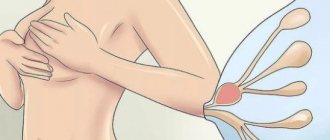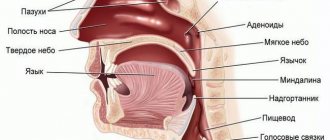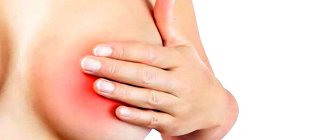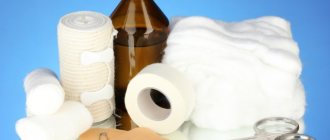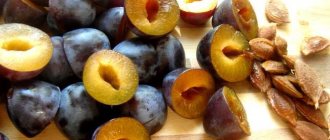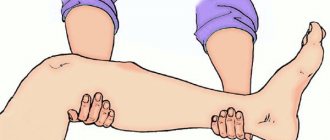Cabbage leaf for pain in the mammary gland
The appearance of even slight discomfort in the chest is a signal to visit a doctor. Most likely, additional examination will be required. As first aid for pain in the mammary gland, traditional medicine recommends local treatment using whole or crushed cabbage leaves. Often other equally important ingredients are added to enhance the therapeutic effect:
- liquid honey (in the absence of allergies);
- sea salt, and in its absence - table salt;
- high-quality butter (not spread!);
- fresh beets;
- kefir (yogurt).
The result obtained is comparable to the use of modern medications that are prescribed for breast pathologies. But you still shouldn’t self-medicate.
Time-tested recipes:
Whole cabbage leaf (cup-shaped)
You need to carefully separate the leaf from the stalk and rinse it with running and then boiled water. Lightly beat on the inner (concave) side until juice appears. It is more convenient to do this with a wooden hammer. Cover your chest tightly, wrap it in a clean cloth and put on an old bra.
With natural honey
Prepare the raw material according to the above recipe, greasing the inside of the leaf with honey heated in a water bath.
Before using the product, the possibility of an allergic reaction should be excluded.
With kefir or sour milk
Fresh raw materials (leaf) are crushed and mixed with 3 tbsp. l. fermented milk product. Apply evenly in a thick layer to both breasts, then wrap with cloth and secure with a bra.
Using butter (fat content > 80%)
A thin layer of butter melted in a water bath is applied to the beaten sheet.
With salt
The leaf prepared according to the recipe is generously sprinkled with salt. To prevent injuries to the delicate skin, the mammary glands are lubricated with olive oil. Recommended for mastitis, fibrocystic mastopathy, breast cancer.
With beet pulp (with added honey)
The beet is ground in a meat grinder, 2-3 tbsp. l. fresh raw materials are distributed over the inner surface of the cabbage leaf. To increase bioactivity, you can lubricate with honey. Compresses based on cabbage, beets and honey show very good results.
Beneficial features
The high bioactivity of cabbage is explained by the presence of substances important for the body, such as:
- provitamin A;
- macro- and microelements (including Se, Fe, P, Ca, K, Zn);
- B vitamins and ascorbic acid;
- amino acids (especially tryptophan, methionine, lysine, histidine);
- cellulose;
- vitamin U
Traditional medicine recommends the vegetable to improve immunity, as an anti-inflammatory and disinfectant. The antitumor, anesthetic and diuretic properties of this product are also known. In addition, cabbage is used to reduce the manifestations of lactostasis (milk stagnation), mastitis, and mastopathy.
Compresses made from fresh leaves help:
- reducing the risk of infection;
- restoration of blood circulation;
- strengthening the outflow and cleansing of lymph;
- suppression of the growth of malignant tumors;
- reducing swelling;
- prevention of cancer.
The therapeutic effect is ensured by the presence of the following components:
- phytoncides stimulate blood circulation, relieve swelling and reduce the risk of bacterial infection;
- indoles restore hormonal balance, which helps reduce the manifestations of mastopathy (fibrocystic);
- ascorbic acid supports the immune system;
- Vitamin U helps cleanse the lymph of accumulated toxins.
Cabbage leaf for lactostasis
Young nursing mothers face lactostasis. The disease is characterized by complaints of chest pain and discomfort when attaching the baby. A woman can independently feel dense lumps, hyperemia and swelling of the inflamed lobe appears, and a vascular network is visualized on the skin.
The risk of developing lactose increases with:
- a certain physiological structure of the mammary glands (here there is a combination of narrow ducts and flat, concave nipples);
- wearing a tight bra;
- improper attachment of the baby to the breast;
- undeveloped sucking reflex in a baby;
- long intervals between feedings;
- low weight of the child;
- excessive production of breast milk.
At the first symptoms, it is recommended to express “to the last drop” and then feed the baby
It is important to empty your breasts as quickly as possible, because delay can lead to more serious consequences - the development of mastitis. A proven method of treating lactostasis is a homemade compress made from cabbage leaves.
How it works
Before making a medicinal dressing, the leaf must be crushed until the juice is released. This juice is a powerful bactericidal agent that, no worse than a synthetic drug, reduces swelling, relieves pain, and reduces the risk of inflammation and infection. Thanks to the diuretic effect, excess fluid is removed from the body and congestion in the mammary glands is eliminated.
This folk method of treatment has been practiced for centuries, so its effectiveness is difficult to dispute, because it is still relevant.
Compress technique
It is recommended to rinse the cup-shaped cabbage leaf with warm running water, dry it with a clean kitchen towel (or hair dryer), and then remove the coarse veins with a knife. In order for the medicinal juice to form, you should slightly mash the inside using a wooden mallet. The sheet treated in this way is applied very tightly to the inflamed area. The bandage is secured with a piece of clean fabric and secured with a nursing bra. The compress is applied, ignoring the nipple area. It’s better to use used underwear that you don’t mind ruining. since the juice “leaks” a little, and this can be an unpleasant surprise.
It is more convenient to apply a compress after the next feeding, since the mother has a couple of hours at her disposal before the baby gets hungry again. The main thing is to endure the procedure for 2-3 hours, and not remove immediately after the top layer has slightly dried. You can leave the cabbage overnight; this will prevent the occurrence of psychological discomfort associated with the risk of the bandage moving when walking or other movement. You don’t have to change the compress while you sleep (if there are no night feedings), remove it in the morning.
After freeing the breast from the cabbage leaves, the mother should rinse the breast before the next feeding.
Cabbage leaf with honey
The recipe involves various options - with the inclusion of natural honey (in the absence of allergies) or high-quality butter. The cabbage leaf is softened in the same way to form juice, and then the inner surface is generously lubricated with these ingredients. Honey enhances the effect of the active substances in the juice and also has an anti-inflammatory and disinfectant effect. Butter softens the skin of the breast, therefore increasing the bioavailability of the biological substances contained in cabbage. Compresses are applied immediately after feeding, changing to a new one every 2-3 hours. The young mother feels relief after just a couple of applications of cabbage leaves, but it is recommended to coordinate your actions with your doctor.
Cabbage compress for a nursing mother - how to make it correctly
A compress of cabbage leaves for lactostasis will reduce inflammation and relieve swelling
Cabbage will undoubtedly help, even if you simply apply a leaf to a sore spot. But in order for the compress from this vegetable to bring maximum benefit, the leaves must be prepared first.
Preparing cabbage leaves for a compress
Since phytoncides are actively released at the moment when the plant is destroyed, it is recommended to beat off the cabbage as follows before applying the compress.
- Remove the top leaves from the head of cabbage; for reasons of cleanliness, they are not suitable.
- Separate the required number of leaves, being careful not to damage them - 2 leaves per serving, one for each gland.
- Pour boiling water over the leaves removed from the head and leave to cool slightly.
- Place the cooled leaves one at a time on a cutting board and lightly beat with a kitchen hammer like chops, also being careful not to tear the leaf web.
- Place the finished cabbage “pancakes” in the refrigerator and use as needed. In this form, the leaves are stored for up to two days.
Rules for applying a compress
A compress is then applied from the prepared cabbage leaves. This is done in the following sequence.
- The cabbage leaf is placed on the mammary glands, covering problem areas.
- Cling film or regular plastic bags are stuck on top.
- A bra is put on that secures this design;
- The chest is wrapped on top with a warm scarf or woolen cloth to create a thermal effect.
Vegetable compresses have an advantage over other types of compresses, for example, with magnesium, in that they can completely cover the mammary glands. When using cabbage compresses there is no need to avoid the nipple area. These ingredients are gentle and will not cause any harm to delicate skin.
Variants of cabbage compresses to enhance the effect
For advanced cases of lactostasis and mastitis, cabbage leaves can also help. Only in this case is it recommended to combine them with other ingredients that also have anti-inflammatory properties:
- carrot;
- potato;
- beet.
Carrots, beets or potatoes added to the compress will enhance the anti-inflammatory effect of cabbage
These products must be alternated in different doses.
Before use, vegetables must be prepared: washed and peeled, then grated on a coarse grater and squeezed out excess juice so that the resulting mass does not drip.
In the case of additional ingredients, the compress is made in the following order:
- beets, carrots or potatoes;
- chopped cabbage leaf;
- cling film or bag;
- bra;
- wool fabric.
Honey with cabbage leaf
Honey is a very active substance that also has an anti-inflammatory effect. But at the same time, nursing mothers often become allergic to honey, even when used externally. The author of these lines also experienced all of the above methods, including a honey compress. Being confident in the absence of allergies (before pregnancy and even while pregnant, I actively used it, there was never a negative reaction) I made a compress without a preliminary sensitivity test. As a result, I ended up with breasts covered in red spots from a severe allergic reaction.
In order not to repeat this mistake, before making a compress with honey, it is necessary to conduct a sensitivity test: apply honey to the inner bend of the elbow and observe the reaction for 24 hours. If even the slightest redness appears, use of this product is strictly prohibited.
If the reaction does not occur after 24 hours, you can use a honey-cabbage compress. It is prepared as follows.
- Honey is applied in a thin layer to the clogged ducts, while continuous application and smearing of the nipple area must be avoided.
- The glands are completely covered with cabbage leaves on top of honey.
- Putting on a bra.
- The wool fabric is fixed.
Cabbage leaf for mastitis
Prolonged stagnation of milk, which could not be eliminated in time, increases the risk of developing mastitis - a serious disease that requires medical attention. An infection occurs, and an inflammatory process rapidly develops in the mammary gland. This often occurs due to a decrease in a woman’s immunity during breastfeeding and exacerbation of a chronic disease, such as tonsillitis. Sometimes the entry point for pathogenic organisms can be a small wound on the nipple, which is formed when the baby is not applied correctly to the breast.
The woman’s health is deteriorating and she is unable to care for the baby. Body temperature rises, severe, obsessive pain is observed in the inflamed mammary gland. The breasts swell and increase significantly in size. Hyperemia of the entire mammary gland appears.
Ignoring the symptoms of the disease can lead to purulent tissue inflammation, which cannot be avoided without the help of a surgeon. Even in such a critical situation, a cabbage leaf can help.
How does it help and how effective is it?
The biologically active substances of cabbage juice help reduce the area of inflammation, relieve pain and remove swelling of the mammary gland. As a result, the patency of the milk ducts is restored, the risk of infection is reduced, and the outflow of lymph increases. A quick response to the appearance of milk stagnation allows you to easily and quickly cope with the problem in a couple of days.
How to apply
For these purposes, a round stalk with cup-shaped leaves is selected. The cabbage is washed, beaten from the inside, freed from coarse fibers. You will need not one, but several soft leaves. The compress is applied after the next feeding after the mammary gland is completely emptied. Warm leaves are placed over the entire area of the chest, as close to the skin as possible so that all the juice is absorbed. The nipple area remains free. Skin gaps cannot be left, so the leaves are overlapped. The compress is covered with a clean cloth to prevent juice leakage, and then fixed with underwear. An old bra is selected that fits tightly, but does not injure the breasts.
The compress stays for up to 5 hours. If you need to feed the baby again, the cabbage is removed, the breast is washed with boiled water, and then a new bandage is formed from fresh raw materials.
You can add natural honey to the recipe. Before using this component, an allergic reaction should be ruled out. The leaves are prepared in a similar way, and the inner surface is smeared with honey. It is more convenient to apply a compress at night.
Lactostasis in a nursing mother, treatment with cabbage leaves
When starting to breastfeed her newborn baby, a mother often experiences inconvenience and even discomfort. Some of them are normal and will go away within a couple of days, while others can lead to serious conditions such as lastostasis and mastitis. How to avoid them? Who should I turn to for help when establishing breastfeeding? Anna Levadnaya, Candidate of Medical Sciences, Head of the Department of Nutritional Technologies, Neonatologist, Federal State Budgetary Institution “National Medical Research Center for AGP named after. IN AND. Kulakov", Moscow.
How can a nursing mother understand that her milk is beginning to stagnate? When can you try to cope on your own, and when should you contact a specialist?
When a woman's milk comes in after childbirth, her breasts become larger and more sensitive. This is what we call breast filling. But at some point it becomes noticeable that the breasts really require emptying - so-called breast engorgement occurs. This is already a signal that the woman needs to regulate the evacuation of milk - feed the baby, express.
The next dangerous moment is when the temperature rises, more pronounced breast tenderness, redness and swelling of the tissues appear. Usually, in this case, the nursing mother’s general health worsens, flu-like symptoms and chills appear. This is already a reason to contact a specialist.
It is important that this person is competent. In principle, it does not matter what education he has - he must have sufficient modern knowledge in the field of treatment of mastitis and lactostasis. This should be a person who will not immediately send a woman to suppress lactation or donate milk for culture.
This could be a gynecologist or mammologist, or a lactation consultant, or a neonatologist, or a pediatrician at the site. I run a breastfeeding support unit and have 375 consultants on staff. Partly these are doctors, there is also a psychologist, an obstetrician-gynecologist - and all of them are breastfeeding consultants.
What should a woman herself know about the treatment of lactostasis and mastitis?
Mom should know that neither mastitis, nor lactostasis, nor breast engorgement are a contraindication for breastfeeding; there is no need to wean the baby from the breast in these conditions.
The first step is to eliminate the cause of lactostasis: you need to establish normal milk evacuation. A lactation consultant can help with this.
If, despite help, the situation worsens within 24 hours, signs of lactostasis and mastitis increase, then antibiotics are necessary.
Milk culture is required only if there is no response to antibacterial therapy, and we suspect some microorganism that is not sensitive to the antibiotics that were prescribed. Only in this case is a culture done to determine antibiotic sensitivity in order to change the antibiotic to an effective one.
Why do lactostasis and mastitis occur?
The main risk factors for the development of lactation mastitis are rare feedings and any other reasons that lead to disruption of the normal, regular, complete evacuation of milk. For example, improper attachment or improper latching on the breast by a child can lead to partial blockage of the milk duct and stagnation of milk. Pressure in the chest area, such as a tight bra or car seat belt, can temporarily cut off circulation in the chest.
There are many reasons for impaired milk flow from the breast - a short frenulum of the baby's tongue, an uncomfortable shape of the mother's nipples, cracked nipples that make feeding painful, improper use of a breast pump, perhaps even a history of breast surgery. The use of a pacifier and bottle at an early age, when so-called nipple confusion occurs, can also disrupt a child's breast latch.
Additional risk factors include diet, stress, excessive fatigue or illness of the mother, and abrupt weaning of the child. Breast engorgement, lactostasis and, if the situation cannot be corrected, mastitis are successive stages of the same process.
In what cases does lactostasis develop into mastitis?
If it was not possible to resolve the problem that led to lactostasis, and stagnation of milk in the breast persists. Human milk is not sterile; it contains various microorganisms. With normal drainage they do not play a significant role, but when the outflow of milk is disrupted, they can cause inflammation.
If we do not resolve this situation at the stage of lactostasis, it will turn into mastitis. If we don’t solve the problem at the mastitis stage, it will be a breast abscess.
When we see lactostasis, we give ourselves 24 hours to try to solve the problem without antibiotics. If this doesn’t work, the symptoms do not go away or even worsen, we use antibiotics so as not to worsen the problem.
How can and cannot be treated for lactostasis? How to treat folk remedies?
No matter how funny it may sound, such a folk remedy as, for example, applying a cabbage leaf to the chest is prescribed in the protocols. In this case, it is a cool object and is suitable to reduce swelling and relieve pain. For relaxation and relief of the mother's condition, we recommend applying a cold compress before feeding. And the same cabbage leaf can fulfill this role. Some popular recommendations are not so bad.
The difficulty is that today we lack medicinal methods for preventing lactation mastitis. The use of lactobacilli Lc40, isolated from breast milk, which formed the basis of a new product for our country, may be the first such method. Spain already has successful experience in the use of this product by nursing women from the first day after childbirth to prevent lactostasis and mastitis.
It is believed that lactostasis is caused by the separate stay of mother and child in the maternity hospital and rare, according to the regime, breastfeeding. Are there still many separate wards left in maternity hospitals?
Naturally, the reason for poor evacuation of milk from the breast can be infrequent feedings, and this often happens when the child is separated. Most modern maternity hospitals strive to move from separate to joint stays.
We at the Kulakov Center for Obstetrics, Gynecology and Perinatology are also trying to do this, but there are certain requirements that cannot be met in old maternity hospital buildings. For example, install sinks so that the mother can wash the child in the room. It is also necessary to convert two-, three-, and four-bed rooms into single and double rooms so that the footage is sufficient to accommodate both the child and the mother. With a large flow of patients this is very difficult.
There is a trend towards living together, but, I think, in many places it still remains separate in Russia - and creates certain difficulties for feeding on demand, which we advocate.
However, in our experience, the risk of developing lactostasis and mastitis can be avoided even when separated - to do this, you need to monitor the signs of breast engorgement. Filling is a normal stage of milk coming in, and engorgement is already a stage when the intervention of a consultant or other specialist is necessary.
Author
Anna Levadnaya
source
Today, dear readers, my article is devoted to one of the very serious problems that can arise in a nursing mother. The birth of a child is the happiest moment in the life of every woman, filled with love, tenderness, endless gratitude for this little miracle, defenseless and completely dependent on us.
In the first months of a small person’s life, it is invaluable to give the child, with his milk, the immunity he needs, on which his health will depend throughout his life. Therefore, it is so important to prepare your breasts for feeding and take all preventive measures to prevent lactostasis.
Lactostasis is one of the most common complications when breastfeeding, caused by stagnation of milk in the milk ducts. There can be many reasons for this, and most often they are associated with the physiology of the mammary glands, when a woman has very narrow ducts or a too small flat nipple, which does not allow the child to completely free the gland from accumulated milk during feeding.
Lactostasis can be caused by excessive milk production, incorrect position of the baby during feeding, squeezing the breasts with a bra and other factors.
Lactostasis must be urgently treated to prevent the development of an inflammatory process in the mammary gland. You definitely need to see a doctor! Cabbage leaf can only be an aid!
When milk stagnation occurs, pain is felt in the mammary gland, a small lump may be felt and redness may occur, in this case you should definitely see a doctor for a correct diagnosis.
In addition to the recommendations given by your doctor, you can successfully help yourself with folk remedies, one of which is cabbage leaves. Cabbage leaf for lactostasis is a proven remedy used by women for a long time, natural and affordable, capable of relieving pain and eliminating milk stagnation in a few days. A cabbage leaf applied to the chest releases juice, which has anti-inflammatory and antiseptic properties, relieves pain and swelling.
For lactostasis, cabbage leaf should be applied immediately after feeding and expressing the milk remaining in the ducts. To do this, the cabbage leaf needs to be properly prepared. Never use cold cabbage leaves. Always take leaves at room temperature. The cabbage leaf itself must be washed, dried with a towel, the rough parts removed, beaten with a wooden mallet, rolled through a napkin with a bottle, or beaten with the blunt side of a knife until the juice appears.
It is cabbage juice that is healing, so a cabbage leaf is applied tightly to the problem area, any clean cotton cloth is placed on top and a bra is put on. Avoid the feeling of squeezing, use old underwear, as cabbage juice can slightly ruin it. There is no need to use a film, as with conventional compresses, the leaves themselves are the compress, only a clean cloth is applied on top.
When using cabbage leaves, avoid the nipple area; after removing the compress, be sure to rinse your breasts with boiled water.
To enhance the effect, the prepared cabbage leaf can be greased with high-quality butter or natural honey, if you are not allergic to bee products. Try to make a compress with honey in the evening, as honey may leak.
Usually, cabbage leaves with lactostasis are kept for 2 - 3 hours, usually during this time the leaf dries out and stops releasing juice. After removing the compress, the breasts should be washed and a fresh cabbage leaf applied.
If you make a compress at night, then leave it until the morning, it will not do any harm. Usually after 2 - 3 days the symptoms of lactostasis disappear. If the situation does not improve, then the development of mastitis can be suspected, and in this case, urgent medical intervention is required.
I suggest watching the video “Lactostasis in a nursing mother, symptoms and treatment.”
Long-term stagnation of milk can serve as a harbinger of mastitis, an inflammatory process in the mammary gland caused by the penetration of microorganisms into the gland tissue. Any microcracks in the nipple serve as a gateway for infection, so during feeding it is necessary to strictly observe the rules of hygiene and feeding the child. The infection can enter the mammary gland through the blood or lymph flow from inflamed tonsils or other foci, which is why it is so important for a woman preparing to become a mother to treat all foci of infection in the body.
Mastitis is a serious disease, all women who have encountered this problem know how painful it is. Body temperature rises, the breasts become hot, swollen and dense to the touch. And if this disease is not defeated at the infiltration stage, then mastitis can go into a purulent phase, in which surgical intervention cannot be avoided.
Therefore, it is important to start treatment as early as possible, and there are many treatments for mastitis in the arsenal of traditional medicine. We are talking about cabbage leaf; it will also help with mastitis, you just need to be patient and apply cabbage leaf to the sore breast every day until the signs of mastitis disappear.
- Cabbage leaves for mastitis are prepared as described above; they should be soft, juicy without rough parts. Before applying them to the sore breast, milk must be expressed. The more severe the situation with the breasts, the more cabbage leaves you will need for a compress. The chest is completely covered with leaves on all sides, only the nipple area remains open, there should be no gaps between the leaves, so they overlap each other. Try to apply the leaves tightly to the skin so that the cabbage juice is completely absorbed. Be sure to cover the top of the compress with a cloth and secure it with underwear. It is recommended to keep such a compress for 5 - 7 hours, but remember that the chest should not cool down, a feeling of warmth should remain.
- There is another folk method for treating mastitis with cabbage leaves. In this case, we also beat the leaves until soft, but additionally lubricate them with heated bee honey and place this side on the chest. It is best to make such a compress at night, but keep in mind that honey may leak, so it is better to wear old underwear.
Since today we are talking about problems with female breasts and treatment with cabbage leaves, I will talk a little about mastopathy, a common disease that women of different ages face.
Mastopathy is a fibrocystic change in breast tissue associated with hormonal imbalance and benign in nature. However, mammologists warn that such changes increase the risk of developing breast cancer, especially in older women, so mastopathy should be taken seriously.
To protect yourself from harm, it is necessary to conduct an annual ultrasound, and for women during menopause, mammography of the mammary glands.
With mastopathy, painful lumps appear in the breast tissue, pain is felt during certain phases of the menstrual cycle, and sometimes this pain is constant, especially when pressed. This problem cannot be ignored; the doctor will advise you to avoid stress, establish regular sleep, give up bad habits and certain foods, and prescribe medications necessary to treat a specific phase of the disease.
Cabbage leaf for mastopathy is one of the reliable, proven methods of treating the disease with folk remedies. But keep in mind that mastopathy cannot be cured in a couple of sessions; you need to be patient for several months and carry out treatment in weekly courses with breaks of 3 to 4 days. The duration of treatment will depend on the severity of the disease and how quickly you begin treatment after diagnosis.
What is the most important thing with lactostasis?
First of all, it is necessary to ensure good emptying of the breast so that stagnant milk comes out of the diseased lobe. Remember that treatment with any lotions, compresses and ointments will not help on its own if there is no outflow of fluid from the chest.
The basic principles that should be followed during milk stagnation are discussed in our article “How to recognize lactostasis and cope with it.” Let us remember that both treatment and prevention of lactostasis involve feeding on demand (including at the request of the mother) and proper latching on the breast by the child.
Try to learn how to place your baby in different positions; if you have lactostasis, point your chin towards the seal. When feeding, lightly massage and stroke the sore area to help the milk come out better.
Most likely, in addition to diligently feeding the child, lactostasis will require additional pumping (from one to three times a day). Most mothers manage to do this on their own, manually or using a breast pump. Manual straining is generally more effective.
Also, if funds allow, you can call a lactation consultant; some of them have a real talent for pumping and provide these services at home. The specialist will also be able to give you detailed advice on both treating congestion and other aspects of breastfeeding.
The effectiveness of cabbage leaves for lactostasis
A nursing mother, faced with such a problem, should be informed about how to use cabbage for lactostasis and the consequences of neglecting this situation.
In order for cabbage leaves to have the desired effect during lactostasis, it is necessary to follow simple but necessary recommendations: how to prepare, how to apply and for what period of time.
The correct temperature regime for the cabbage leaf compress should be observed for lactostasis. A cold leaf can cause inflammation and mastitis. A hot compress will provoke the rapid development of pathogenic microflora. Body temperature is optimal.
What is the connection between lactostasis and cabbage leaf? The anti-inflammatory effect is due to its chemical composition.
He is capable of:
- relieve pain;
- remove swelling and stagnation;
- eliminate damage in the form of cracks and abrasions on the nipples;
- prevent the appearance of mastopathy in areas of compaction.
How does cabbage leaf help with lactostasis?
- The vitamin complex helps accelerate cell regeneration and stimulates metabolic processes.
- Potassium, together with phosphorus, increases cell permeability and improves fluid outflow.
- Enzymes break down toxic substances.
- Acids help accelerate regeneration processes.
- Lysozyme and phytoncides have bactericidal properties and prevent pathogenic flora from entering the gland.
Preventive measures to prevent illness
Prevention of lactostasis allows you to avoid many symptoms of the disease. To implement it, a woman must follow certain rules.
If a nursing mother feels that her breasts are full, but an attempt to feed the baby is met with his refusal to eat, he needs to express the milk a little by hand, but not completely. This is done until the woman feels that the herd's breasts are soft.
Doctors recommend that young mothers feed their babies in different positions. This allows the breasts to be emptied of milk evenly and prevents the development of the disease.
Preventive measures include daily washing of the mammary glands with warm water. You also need to express milk a little before feeding your baby. This allows the baby to suck out what is called late milk, which is much more nutritious and thicker than the initial flow. But it is better not to do the pumping process unless absolutely necessary. It is recommended to follow the previously mentioned advice only with periodic breast fullness.
A nursing mother should protect this organ from hypothermia, not wear tight clothing, and observe hygiene rules. For example, after giving birth it is better not to wear regular bras. It should be taken into account that the mother's breasts increase after the birth of the child, so you will need to wear a special version of the bra when feeding. Its cup is made of soft fabric, there are no bones or rough seams. This bra supports the breasts well and does not restrict them at all.
A woman should get more rest, as overwork can lead to poor health.
https://ipupsik.com/zhenskoe-zdorove/zhenskie-bolezni/simptomy-i-lechenie-laktostaza-u-kormyashhej-materi.htmlhttps://uroki4mam.ru/laktostaz-u-kormyashhej-materihttps://kidfeed. ru/zdorove-mamy/simptomy-i-lechenie-laktostaza-u-kormyashhej-materi.html
How to properly apply cabbage leaf for mastopathy
To achieve successful treatment of mastopathy, cabbage should be applied correctly to the mammary glands. It is best to take whole leaves. This will make it possible to place them over the entire surface of the chest and not worry about the compress slipping out of place. In addition, the juice from the leaf is released gradually, which ensures a long-lasting effect.
The cabbage compress is extremely easy to apply:
First of all, the sheet needs to be washed, beaten a little and secured to the chest.
To do this, you can use a bandage, a piece of gauze or cotton fabric. Duration of application is 2–3 hours. If desired, the procedure can be performed overnight to ensure the longest possible effect.
The addition of other components will help enhance the effectiveness of cabbage compress in the treatment of mastopathy.
Beekeeping products have anti-inflammatory and antitumor properties. The washed and beaten sheet should be smeared with honey and applied to the chest with this surface. Secure with a bandage or wear a worn cotton bra. The main thing is that it does not squeeze the mammary glands. The time for applying the compress is 4–6 hours. Duration of treatment is up to 2 weeks.
Bee products are potential allergens. Therefore, if a woman has not consumed honey before, she needs to do a test for an allergic reaction (smear the inner surface of the forearm with honey and leave for 10-15 minutes).
A kefir-cabbage application will help quickly relieve pain. To do this, 3–5 young and fresh cabbage leaves should be chopped with a knife, blender or minced. Add 3-4 tsp to the mixture. kefir or sour milk. Place the mixture on a piece of gauze and apply to the sore spot. When the napkin dries, it needs to be replaced with a fresh one. The medicine should be applied daily for several weeks.
Good results are shown by using a compress of cabbage, honey and beets. To do this, beat 1 leaf of the vegetable with a hammer until the juice releases, place 3 tbsp on it. l. grated raw beets and 1 tbsp. l. honey For better heating, the application must not only be secured to the surface of the chest, but also wrapped. This will help ensure deeper penetration of the active components deep into the epidermis. The procedure is best performed at night for 7–10 days.
Treatment of mastopathy with cabbage leaves provides relief after the first use. The tumor subsides, the pain subsides, and the inflammatory process gradually declines. In order for treatment to bring a positive result, you need to act as follows:
- Wash the sheet.
- Brush with melted butter.
- Sprinkle lightly with salt to release the juice.
- Press the sheet to the mammary gland, securing it with a piece of natural material.
- Do not wear tight underwear on top.
- Keep the compress for 3 to 6 hours and then replace it with a new one.
There is also a recipe for treating mastitis with cabbage leaves and honey, which is only slightly different from the previous one. The main difference is points 2 and 3. Instead of oil and salt, a layer of honey is applied to the leaf.
Cabbage leaf for mastopathy - effective treatment
However, not everyone knows that there are quite effective folk remedies for the treatment of mastopathy. The ordinary leaf of white cabbage has long and successfully become an assistant in the fight against this disease.
Cabbage leaf is a reliable healer
The healing properties of cabbage have been known for a long time. Pythagoras and Hippocrates also wrote about its use in medicine. The Mediterranean region is considered to be the birthplace of cabbage.
Cabbage appeared among the Slavs about two thousand years ago. And almost immediately, healers began to use the ability of its leaves to have a beneficial effect on tumor processes. This technique is still used today.
So, in order to start fighting mastopathy with cabbage, you need to take a medium head of this vegetable.
Compress recipes
In addition to the classic use of softened cabbage leaves, you can use compresses with additional components that activate or complement the effect of this healing vegetable.
With honey
For lactostasis, it is recommended to use cabbage leaves with honey. This beekeeping product also has antiseptic and anti-inflammatory effects. To do this, grease the softened sheet with a small amount of honey and apply it to the gland, taking into account the general recommendations. Cover the breasts with a cotton piece of cloth, as the honey will bleed through and ruin clothes and bedding.
With butter and salt
Mix butter and salt in equal proportions. Grease the washed, softened cabbage leaves with the prepared mixture. Attach them and secure them using a bandage or loose bra. Leave for about half an hour, remove, wash the glands with water at a comfortable temperature.
With curdled milk
For intense pain, it is recommended to grind the leaves using a meat grinder, pour in sour milk in a ratio of 2 to 1. Apply the resulting mass to a cloth and cover the entire area of the gland. Dried fabric needs to be replaced.
Lactostasis in a nursing mother
The joyful event of the birth of a child is sometimes overshadowed by a problem with breastfeeding - lactostasis - stagnation of milk in a nursing mother. There are many reasons for the development of this painful condition in women who have given birth; those who have a large bust size are especially affected. To prevent stagnation in the mammary glands, you need to know about the provoking factors:
- partial compression of the breast directly during feeding;
- temporary cessation of breastfeeding;
- fatigue;
- inability to properly attach the baby to the breast;
- nervous tension;
- small number of feedings per day;
- stressful state;
- inappropriately tight underwear;
- hypothermia;
- mechanical chest injury;
- the main position during sleep is on the stomach;
- anatomical obstruction of the mammary glands.
What is lactostasis?
Lactostasis is a complication of breastfeeding, characterized by congestion in the mammary glands of a nursing woman. Those who give birth for the first time are especially vulnerable. The likelihood of developing the disease is high in the postpartum period, from the first few days to one and a half months.
Against the background of microcracks in the nipples that occur during feeding and an environment favorable for the proliferation of pathogens, an inflammatory process may develop in the milk ducts.
How does it manifest?
The first signal of the development of lactostasis is in the behavior of the baby, who, while remaining hungry, becomes capricious and whiny. The cause of malnutrition is an interrupted current or a thin stream of milk. Then, after a few days, the picture of the pathology appears more clearly:
- the breast becomes dense/rough;
- touching causes pain;
- pumping is painful due to distension of the mammary gland;
- milk flow is weakened;
- pain in the armpits;
- When examining the breast, you can feel lumps, over which the skin turns red.
The temperature may rise briefly (up to 380C), but the nursing mother’s well-being does not deteriorate. She sleeps normally, eats, and takes care of her baby.
How to understand that this is lactostasis?
Usually the problem is pronounced, so identifying it is not difficult. Among the many characteristic symptoms of lactostasis, the main symptom is pain and discomfort in the mammary glands of a nursing mother. They are impossible not to notice. The pain is accompanied by:
- feeling of fullness or heaviness in the chest;
- a meager stream of milk when expressing;
- local temperature increase;
- Reddened lumps can be felt in the chest, which hurt when pressed.
When the temperature persists for a long time, and the symptoms become more and more pronounced, you can fear the development of an infectious-inflammatory process. Lactostasis occurs practically without complications, without high fever, and is eliminated almost immediately as soon as the baby is properly applied to the breast during feeding.
What is mastopathy and why does it occur?
These compactions can appear in several places at once and in a “small form”. However, you shouldn’t be too scared of them - the disease is benign and can be treated, including non-traditional ones.
But mastopathy is fraught with a serious danger - it can develop into a malignant formation. Already, the symptoms of mastopathy often resemble breast cancer. Therefore, it is impossible to delay the treatment of this disease.
The causes of mastopathy are different:
- Hereditary factor. If your maternal relatives suffered from benign or malignant tumor diseases of the breast, your risk of suffering mastopathy increases many times.
- Prolonged stress. It has long been known that mental disorders greatly weaken a person’s immunity and reduce the body’s resistance to diseases. A woman’s mammary glands are vulnerable to inflammatory diseases, especially during certain periods of her life.
- Artificial termination of pregnancy. Abortions, especially multiple ones, always carry the risk of complications, including severe ones.
- Chest injuries. Breast tissue has a delicate structure. Any external influence can lead to the onset of an inflammatory process.
- Iodine deficiency. Lack of iodine negatively affects the metabolism in the body. As a result of disruption of this metabolism, harmful substances that provoke the development of mastopathy are retained in the tissues.
- Long-term use of contraceptives. In this case, the hormonal balance is disrupted, which often leads to the formation of tumors.
- Previous surgery on the uterus or ovaries.
- Excess prolactin in the body , a hormone that is responsible for milk production and the condition of glandular tissue.
- Refusal to breastfeed the child. In any case, this is a violation of the natural process occurring in the female body. Which causes subsequent diseases.
- Smoking and alcohol. As cliché as it may sound, abuse in this regard weakens the immune system.
How the disease begins
There are several factors indicating that mastopathy is beginning to affect the mammary glands. And it doesn’t necessarily have to be tangible breast lumps.
- Sometimes the disease begins with unexpected discharge from the nipple. They can be of different colors and composition. In addition to white discharge, there are, for example, yellow or greenish discharge - they signal the beginning of a serious inflammatory process. Red color, unfortunately, can signal the onset of cancer, so in this case, do not hesitate to consult a doctor.
- Often the disease comes with chest pain. Sometimes they come during or before menstruation, so women often perceive painful sensations as a natural phenomenon. Over time they increase. The pain becomes dull, aching, radiating to the neck or arm. If mastopathy affects the left mammary gland, the pain may be mistakenly perceived as a heart disease.
- Swelling of the mammary glands. It can be absolutely painless, but it does cause some discomfort. This is also often mistaken for a normal phenomenon accompanying menstruation. However, this is a mistake.
- An unmistakable symptom is lumps in the mammary gland. Moreover, at the initial stage they may not always be painful and easily palpable.
- Sometimes, along with unpleasant sensations in the breast area, there is an increase in the axillary lymph nodes and their soreness.
If you experience any of these symptoms, you should immediately consult a doctor. The sooner the disease is detected, the faster its development will be stopped, and treatment will take place without complications.
Signs and causes of lactostasis
Stagnation of milk in the breast does not necessarily occur on the third or fourth day after the birth of the baby, although such cases occur most often. Lactostasis can begin several months or even a year after the start of feeding, if there is a lot of milk and the baby is not very active in eating. Often, stagnation is provoked by violations of the regime, when the mother needs to leave the house for the whole day, and she misses several feedings at once. When the baby begins to be fed vegetables, meat and fruits, he sucks out less milk, as a result, the actively working glands become clogged.
- nagging pain inside the breast, which subsides slightly after feeding the baby, massaging the gland or pumping;
- a feeling of the breast being full of milk, as if it was bursting from the inside;
- local hyperthermia, when body temperature remains normal but is increased in the chest area;
- painful lumps in the area of which the skin turns red and swells.
In order to take timely measures, the primary symptoms cannot be ignored, since after 2-3 days the inflammation will turn into an infectious process, and then into purulent mastitis. The onset of such infection is marked by an increase in temperature, first to subfebrile and then febrile levels, diffuse redness of the chest and severe swelling.
There are many reasons for milk stagnation. It is worth listing the main ones:
- feeding is constantly in the same position - the child cannot absorb all the lobes of the gland, which is why a blockage of the duct occurs in a certain area;
- wearing a constricting, tight bra and sleeping in a position on the stomach - milk cannot flow through the ducts to the nipple and clogs the gland with hard lumps;
- increased lactation - fluid enters the glands in increased quantities, the baby does not have time to suck out the milk, and stagnation is created. The reasons for accelerated milk production are a large volume of fluid consumed, pumping unnecessarily, incomplete emptying of the gland;
- individual characteristics of the female body, such as the production of too fatty and viscous milk, narrow milk ducts, sunken nipples, which do not allow the baby to attach correctly and fully suck the breast;
- chronic fatigue, stress, general or local hypothermia, chest injury - a severe bruise causes swelling and compression of the gland ducts;
- accustoming the baby to a pacifier - the child begins to latch on to the breast less actively, which is why the milk stagnates at the same volume of lactation.
An unstable emotional state can also provoke congestion in the chest, caused by blockage of the milk ducts. Therefore, doctors strongly advise nursing mothers to get proper rest, not to overwork physically and mentally, and to avoid stress and colds.
Causes of lactostasis
The main reason for the development of lactostasis is stagnation of milk in the mammary glands. The breast becomes inflamed and infection may develop over time. Young mothers should undergo a consultation, which will tell them how to properly put the baby to the breast, how many times to feed him, how to avoid stagnation of milk if the baby sucks less than the body produces.
The most common factors that provoke the development of lactostasis include the following:
- A woman puts her baby to her breast incorrectly;
- Incorrect retention of the mammary gland during feeding;
- Increased activity of secretion of the mammary glands;
- Tight underwear;
- Damage to the nipples;
- Injuries;
- Hypothermia;
- The special structure of the ducts, nipples or mammary glands themselves.
Another fairly common reason for the development of the disease is dehydration of the body, when too thick milk begins to be produced. It passes through the ducts more slowly and is more difficult to discharge from the nipple.
What is lactostasis and the reasons for its occurrence?
Lactostasis is stagnant processes in the milk ducts. If they narrow, the movement of milk becomes difficult, and its outflow decreases. Dense areas appear, the gland in this place hurts. Painful sensations are also felt during the feeding process.
Insufficient emptying of the gland leads to increased pressure in the lumens of its ducts. Swelling occurs, the inflammatory process of the tissues in this area begins, which consequently causes pain. In addition, increased pressure in these areas reduces lactation. Milk that does not leave the gland begins the process of inverse absorption, which is characterized by an increase in temperature and the so-called “milk fever” develops.
Factors that provoke the appearance of lactostasis include:
- violation of breastfeeding technique, in which the baby empties only a separate area of the chest;
- pinching and improper squeezing of the breast with fingers when feeding;
- position on the stomach during sleep, in which compression of the glands is observed;
- use of tight underwear;
- trauma and damage to the nipples, which complicates feeding;
- draft or cooling;
- individual physiology of the structure of the breast and ducts, flat nipples;
- dehydration, milk becomes thick.
How to treat at home
If a nursing mother experiences lactostasis, then you can cope with it with home remedies. The main thing is not to be late with treatment. Another woman felt the development of stagnant processes; she must adhere to a number of recommendations:
- To enhance the flow of breast milk during lactation, it is necessary to stroke and massage the breasts before feeding. Movements are directed towards the nipple until the symptoms disappear, even if you have to endure painful discomfort.
- To alleviate a woman’s condition, cool compresses are placed on her breasts between feedings and pumping.
- Your breasts should be kept warm before feeding or expressing milk. Do not feed if you feel chills. However, excessive heat is also contraindicated, as this can activate the action of pathogens that have penetrated inside.
- After warming up the breasts, you need to massage them in places with seals.
- When you finish pumping, you can put the baby to the breast so that he takes in all the rest of the milk;
- Excessive force during massage is harmful because it can cause damage to the ducts. This will only worsen congestion and cause an increase in temperature;
- If you treat lactostasis at home incorrectly, you can ruin lactation, leaving the baby without breast milk.
If there are obvious signs of inflammation, you should stop any warming procedures and seek help from a doctor. The symptoms will be:
- increase in body temperature for more than a day;
- increasing pain;
- redness and hyperemia of painful areas of the skin.
How to treat lactostasis?
Lactostasis occurs in more than half of women who gave birth for the first time. It should be treated immediately. The condition is accompanied by unpleasant symptoms: pain, lumps, increased body temperature, redness of the chest. If the problem is not solved in time, lactostasis can develop into a more complex disease - mastitis.
When the first manifestations of the disease are detected, measures should be taken immediately, since if stagnation lasts longer than two days, the risk of developing mastitis rapidly increases. What is the treatment for lactostasis?
At home, a woman can take the following measures:
- Correctly attach the baby to the breast;
- Apply more often to the chest where there is congestion;
- Before feeding, apply warm compresses and take a warm shower;
- Apply lotions after feeding.
If the stagnation does not go away on the first day, the body temperature rises, you should visit a mammologist’s office. The doctor may prescribe medications; if the risk of mastitis is high, then anti-inflammatory and antibacterial medications.
What is mastitis
Mastitis is an inflammation of the mammary glands. Typically, this disease is caused by Staphylococcus aureus bacteria. And the “entrance door” for these pathogenic microorganisms is usually the cracks that form on the nipples at the very beginning of breastfeeding. Also, staphylococcus can enter the breasts through wounds, eczema and other, sometimes minor, damage to the skin of the mammary glands.
Symptoms
Mastitis (in common parlance – breastfeeding) in most cases occurs as a consequence of lactostasis.
And its symptoms, in addition to pain, excessive hardness and swelling of the breasts, include:
- increased body temperature;
- chills;
- feeling of tension in the chest;
- swelling of the nipple.
It is important to remember that not only nursing mothers or pregnant women can get mastitis. This disease affects women aged 15 to 60 years, and in rare cases it can also affect newborn girls due to improper regulation of hormones in the body of a nursing mother.
